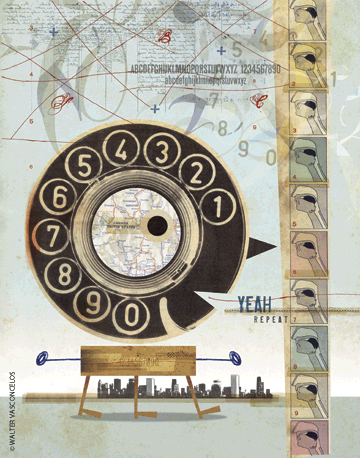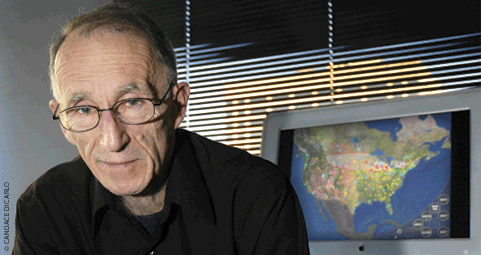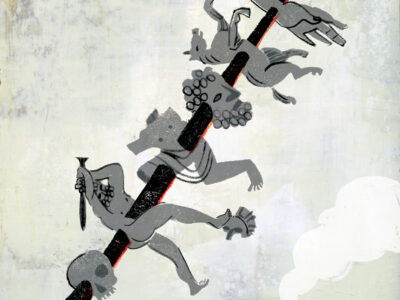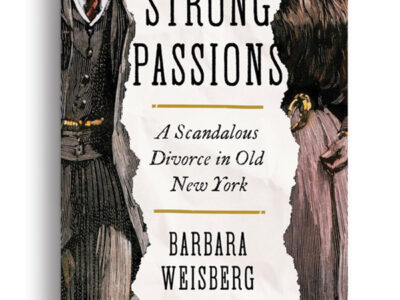
In his latest work, an atlas of North American English, Penn sociolinguist Bill Labov shows that we are talking more differently from one another.
By Susan Frith
Sixty-one-year-old Isaac is reminiscing about a “tar far” near his hometown of Winston Salem, North Carolina. The smoke from it was so heavy, he claims, “some congestion I had, it came lewse!”
April, a college student, describes the “dawntawn” of Rochester as “pretty bee-ad” in some areas. That’s why she goes shopping in the suburbs.
Arnold from Arnprior, Ontario, frets over the cost of buying a “hose” in the capital city of Ottawa.
Thanks to William Labov, I can hear their distinctive dialects without leaving my computer.
Labov, the John H. and Margaret B. Fassitt Professor and director of the linguistics laboratory at Penn, has just released The North American Atlas of American English, a book and CD-Rom that take their users on a linguistic journey across the continent. Instead of mapping highways or state parks, the atlas (published by Mouton de Gruyter) defines the boundaries of how people talk and charts sound changes in progress throughout the United States and Canada. The data comes from phone interviews with 762 subjects in dozens of North American cities between 1992 and 1999. Though linguistic atlases have been created before, this one—co-written with Sharon Ash G’74 Gr’82 and Charles Boberg Gr’97—represents the most comprehensive record of the phonology—the actual sounds—of North American speech.
“It’s been a terrific resource for everybody in the field; it’s a formidable piece of scholarship,” says Gregory Guy G’75 Gr’81, a sociolinguist at New York University who, like perhaps half the scholars in his field, studied under Labov. “I look at this and think, ‘How can anybody have the energy to do anything this comprehensive?’”
“There are language changes all around us, and you can see it in our atlas,” Labov says, flipping through its dozens of color-coded maps during a recent visit to the linguistics lab. “The first thing it does is show people that the notion that [regional] dialects are disappearing is wrong, and secondly, that deep divisions in American life are still there, reflected in linguistic patterns.”
Labov points out that there is “no continuum” linking the major regional dialects. “There is the north, there is the midland and the inland south, and there is just an absolutely sharp line between them.”
Even more pronounced than the regional boundaries marked in the atlas, he points out, is the fact that African Americans—and, to some extent, Latinos—living in cities throughout the country are not participating in the sound changes of their regions. “Language is a very sensitive reflector of social reality and what’s happening around us.”
Labov has been teasing apart linguistic patterns for four decades, studying sound change on Martha’s Vineyard, the social stratification of r-pronunciation among New Yorkers, the complexity of African American Vernacular English (AAVE), and how people monitor clues about social class in each other’s speech, to name just a few lines of research. For the past decade he’s been using sociolinguistic principles and an understanding of AAVE to try to raise reading levels among students in inner-city schools.
Crucial to all of the work of his lab, he says, is going beyond its walls and crossing the barriers between the University and the speech community. “When we meet people and sit down and talk with them, the understanding is that we have something to learn from them and we are really interested in what they have to say.
“Like everyone else,” he adds, linguists “are fascinated with language differences because deep down we believe that there is a right way to say something, and if someone has a different way of doing it, why there’s something strange going on.”

“Say bat.”
“Bat,” I repeat.
“Can you feel where your tongue is?”
Labov is trying to explain a diagram that I find quite abstruse—a swirl of vowels connected with directional arrows that signify the Northern Cities Shift, a sound change that began in the 1960s and encompasses 34 million people living in the Great Lakes region. Labov’s atlas identifies it in a swath of cities stretching from Syracuse to Chicago to Milwaukee, and dropping down the I-55 corridor to St. Louis.
“These are measurements of acoustic properties that correspond pretty well to where the highest part of the tongue is,” he explains. “Now say bet.”
“Bet.”
“No you can’t.” (Well, that’s how it sounds in my native Virginia.) “Say yeah.”
“Yeah.” Is this how Eliza Doolittle felt?
“Now go say that’s where.”
“That’s where.”
“Hear your tongue going up when you come to where? It’s higher in your mouth. Now say ee.”
“Ee.”
“The blade of your tongue is very close to the roof of your mouth.”
As Labov continues the tour of my mouth, he explains that sound is produced by an opening in the larynx known as the glottis. As it travels through the mouth, the tongue’s position reinforces certain harmonics and suppresses others. “That’s [similar to] what makes a bassoon sound different from an oboe,” Labov says. “They both can play the same note and sound very different, because different harmonics are reinforced.”
In the Northern Cities Shift—just as in the Southern Shift, the Canadian Shift, and the Pittsburgh Shift described in the atlas—changes in tongue position lead to a rotation of vowel sounds: Sockssounds like sacks would sound in other dialects. Man comes out as myeahn. Desk sounds like dusk. And bus sounds like boss. “But that’s only in the most advanced speech,” says Labov. “In most places it’s just a movement in that direction.”
Labov cites the television show NYPD Blue as an example. “Tell me who doesn’t fit in. It’s Dennis Franz, who’s from Chicago. He has a very strong Northern Cities Shift. So when Dennis Franz says, ‘What he-appened?’ Americans say, ‘What’s he doing in the New York City police department?’”
The Southern Shift—like a train heading down a different track—is taking vowel sounds in another direction: Say goes toward sigh. Weight is heard as white. Beat sounds like bait.
“It’s reached its maximum in areas [like] Tuscaloosa, Chattanooga, Knoxville, Birmingham, and the central Appalachian area,” Labov says. Interestingly, in the South, the smaller the city and the older the speaker, the stronger their accent is. In the North, the reverse is true: the younger the person and the bigger the city, the stronger the accent.
One of the many linguistic mysteries that occupy people like Labov is why the North American settlement patterns that established dialects many years ago are still reflected in sound changes today. The Northern Cities Shift, for example, “arose and [began to] spread 100 years after the main settlement lines were established, and it stops short on the same boundary.”
Given the sound changes he’s documented, if someone were to take a road trip around the country a century from now, would they be able to understand the person at the next gas pump?
“They may think they’re understanding [each other],” Labov says, but there will be changes that will lead to misunderstandings they’re probably not even aware of.”
While some sound changes seem to have reached a maximum, others appear to continue, says Labov. In many parts of the country, the girl’s name Ann now sounds like the boy’s name Ian, but this name-morphing seems to have reached its limit. In Philadelphia, the word paid is changing so it sometimes is mistaken for peed. “Sound change can go on and on, but it will take different forms.”
Years ago, at the end of a dialectology conference in Victoria, British Columbia, Labov offered his friend and colleague Dennis Preston a ride to the airport. On the way there Labov got a bit distracted.
“He said, ‘Dennis, did you know that in African-American English you can say nasty to refer to the way things taste? Isn’t that an amazing fact?’”
In his Louisville lilt Preston informed him that it was a Southern expression. In the South, he said, “I guarantee you that white people and black people alike think something tastes nasty.”
“Bill loves to get that kind of information,” recalls Preston, now a linguistics professor at Michigan State University. “He said, ‘What do you mean, “all Southerners can say that?!”’ I almost missed my plane because we got so engrossed in talking about specialized lexical items for different groups that he overshot the airport by several miles.”
Walt Wolfram, a sociolinguist at North Carolina State University who studies “endangered dialects” such as Outer Banks English, laughs knowingly when he hears this story. “The thing about Bill is he’s totally obsessed with his current research thoughts. For example, a cab ride with Bill is like a classroom lecture. At times his wife, Gillian (Sankoff, a professor of linguistics at Penn) will even say to him, ‘OK now, Bill. We’re socializing.’ You take it as a token of his sort of immersion in and enthusiasm for what he does.”
The teasing by Labov’s colleagues comes with a heaping helping of admiration.
“Bill Labov is the indisputable architect of contemporary sociolinguistics,” Wolfram says. “Furthermore, a half-century after its inception, he remains its more foremost researcher. I can’t imagine any scholar having a more significant and sustained impact on any field of social-science inquiry than Labov has had on sociolinguistics and dialectology. He is without peer—it is that simple.”
Preston says Labov’s belief in the value of dialect studies has helped to bring the field of dialectology out of its “doldrums.” The new atlas “employs the kind of techniques in collecting data that you would typically use in sociolinguistics, but it answers such enormous old-fashioned questions as: how many dialect areas are there in the United States and where does one thing stop and another begin? By doing that he lent some respectability to the field.”
“He really is one of the most influential people in higher education in the 21st century,” adds Guy Bailey, a linguistics professor and the chancellor of the University of Missouri-Kansas City who considers a conversation he had with Labov when he was a young doctoral student as the turning point of his career. “The thing that amazes me is that most of us reach a point where we kind of slow down, if not in the amount of work we do, at least in creativity,” Bailey adds. “But even as Bill moved into his seventies, he was a step ahead of everybody. He has not slowed down, and he’s still running faster than the rest of us.”
Before he cultivated an obsession with glides and diphthongs, Labov worked as an ink maker. “The first thing you learn [in that business] is that there is an objective world out there which quickly proves if you’re wrong or right,” he says. “So if you spray a panel with enamel and come back six months later and discover it’s all cracked up, you know you did something wrong.”
When he returned to graduate school to study the new field of linguistics, Labov applied a similar set of principles. “I began with the notion that you can build a science of linguistics based on the data we have all around us, the way people talk in real life rather than based upon our intuitions or feelings about language or what we read in books.”
One issue that concerned him was that “people don’t always say the same thing in the same way they think they do. When you actually record their speech you need much more sophisticated tools of analysis” than had been previously used.
For his dissertation at Columbia, Labov researched class differences in the dialect of New York City and developed new interviewing techniques as well as quantitative ways to measure sound change. (In one of the studies, by asking employees of Macy’s, Saks, and Kleins for directions to the shoe department, he found that r-pronunciation varied according to age, social class, and style of speech—careful or casual.)
He next turned his attention to the youth gangs of South Central Harlem in a major study of African American Vernacular English, a dialect spoken by many African Americans across the United States. Labov asserted that this dialect contains as much complexity as Standard English, but is devalued as part of the institutionalized racism of American society [“Cool Bill,” December 1973]. “The people of Harlem back in the 1960s that we dealt with taught us a lot about African-American English, but we didn’t help them that much,” says Labov. As he later learned, most of the subjects “would be sent up to prison, shot, or dead.”
He came to Penn in 1970, finding Philadelphia a strategic site for research because “two-thirds of the vowels were changing” here. “So we did a big study in Philadelphia, where we asked who is responsible for language change, and since then we’ve had many other projects, which culminated in the study of the whole continent.”
According to Labov, the leader of language change tends to be a “high-prestige local person”—most often a woman—who has many interactions with neighbors as well as connections outside the neighborhood. A block captain, perhaps.
Television and the radio don’t carry much influence—at least not at the level of sound change. “People seem to be influenced almost entirely by whom they speak with face to face,” he says. African Americans, for example, “don’t participate in any of the sound changes and they’re exposed to the same radio and television as everybody else.” Due to residential segregation in the big cities, “African Americans don’t deal face to face with speakers of other dialects” in a meaningful way.
“The mysterious thing is that most of the changes we’re talking about are quite unconscious,” he says. For example, the Northern Cities Shift is “absolutely invisible and inaudible to the people who are doing it.”
Another issue that intrigues Labov is why sound changes seem to travel from one city to the next largest city. “Is it the salesmen and wholesalers who come out from the big cities to the small cities?” he wonders. “Or is it the people from the small cities who come out to the big cities to see the ball game and go shopping?
“But the biggest mystery of all in our studies of transmission is this: Language change is a process that occurs over many generations, where the children learn to speak from the parents and then to speak differently from their parents—and in every generation they learn to speak differently in the same direction,” Labov says. “How this happens we don’t know … yet somehow, after a decade goes by, they are pushing the language change further.”
Labov bounds into the classroom wearing sneakers, a leather jacket, and jeans fraying slightly near one ankle. He’s 78, and though the lines on his face shows his age, his energetic manner belies it. (He can run a respectable three to five miles at a slow clip.)
The students in his Social Linguistics of Reading class are sitting around a table in the linguistics lab overlooking 35th and Market streets. Just a few blocks away stands the Drew School, where the students tutor second- and third-graders each week.
Posters on the walls chart the young readers’ progress, noting “trouble spots” such as “still struggles with silent e at times.” But as Labov makes clear, the tutoring sessions are only part of the story.
“We’re all faced with a difficult situation,” he says, perched at the edge of his chair and peering at his students. “A lot of our kids are being thrown out of school for fighting … The first thing we have to think about is why kids are getting into so much trouble. What alienates them from school?”
Labov mentions a recent conference on endangered dialects where he gave a talk titled “Unendangered Dialect, Endangered People.” As residential segregation increases in American cities, he says, African American Vernacular English has diverged from other dialects, and that divergence correlates with a host of social, economic, and educational problems. According to Labov, students’ use of AAVE leads teachers to predict behavioral problems and reading failure. “By continually telling children that they are not speaking English, teachers may alienate children from engagement in learning to read,” he adds. Inadequate instruction, combined with under-funded schools, means that “a majority of children in inner-city schools are failing to learn to read, with a developing cycle of poverty, crime, and shorter life-span.”
Labov tells the story of a girl who came to school wearing a necklace with two photographs—a little boy on each side. When the tutor asked who was in the photos, the girl replied, “My two brothers, who were shot to death last year.”
“This,” he says, “is not uncommon.”
With students’ input he has spent the past 10 years developing a reading program that he hopes to spread around the country. It has already been used in Philadelphia, Baltimore, and Chester, Pennsylvania.
“We use linguistics to find out what children know about the alphabet; we use our knowledge of African-American English to attack the problems that are particularly difficult for the kids involved; and we use our knowledge of kids to know what they’re really interested in,” Labov says. The reading materials he’s developed are full of wizards and monsters as well as plotlines that reflect real-life conflicts. When a Penn tutor pointed out that the students they worked with hated tests, Labov transformed a word test into the Tower Game: “Every time they read a word, they get a chance to pull a domino off the stack in front of the tutor and build their own tower. So when the tutor doesn’t have any left, they win.”
The program has had some success. In the 2003-04 school year, participants’ scores on Word Attack standardized tests, which are designed to measure the ability to analyze unfamiliar words, rose from the 21st to the 30th percentile. Early results from this year’s testing are promising, says Labov.
“But the major thing we’ve done is to teach a lot of kids who say, ‘I hate to read, I refuse to read’ … to turn them around to the point where they actually like what they’re doing.”
With a voice as elastic as Jim Carrey’s face, Labov can summon a dialect like old Charleston’s faded “It wouldn’t be fayuh to go theyah” in a heartbeat. But he can’t necessarily guess your hometown. And forget about telling which neighborhood you live in.
“The notion that you can tell what block a person is from—that comes from Henry Higgins and is a myth,” says Labov, whose own Rutherford, New Jersey, accent often leads him to be mistaken for a New Yorker. “If a working-class New Yorker comes from the Bronx or Brooklyn, there’s no way I’d be able to tell that. There are those dialects I know well, like New York and Philadelphia and Chicago, but I could not place someone from Chicago as opposed to Rochester.”
His linguistic acumen has had some remarkably liberating effects, however.
Some years ago, a man named Paul Prinzivalli was accused of phoning in bomb threats to an airline at the Los Angeles airport. The airline executives fingered him for the crime, claiming the voice on the tape sounded like his. But the accused came from New York City, and to Labov, the accent on tape was obviously Bostonian.
“I was able to show by acoustic measurements and experiments of various kinds that it was actually impossible for Paul Prinzivalli to have made that recording.” Labov recalls. “The judge said, ‘I find this man innocent on the basis of the linguistic testimony, because it’s the most objective testimony I’ve heard in years.’ So it was quite a compliment.”
Though their own freedom may not depend upon it, New Yorkers tend to be the most self-conscious about their speech, closely followed by Southerners, Labov says. Wherever they are from, most people were eager to talk to the interviewers who worked on the North American atlas.
It also appears that most people are equally fascinated with the way that others talk: Labov has been asked to convert his atlas into a book for a popular audience.
Though its major features have been mapped, Labov continues to explore the linguistic landscape. He cites a number of regional studies growing out of questions raised by the atlas. “The United States as a whole is a puzzle,” he says, “and we’re still putting the pieces together.”
For a demonstration of how the atlas works, see the publisher’s website, http://www.atlas.mouton-content.com/.




